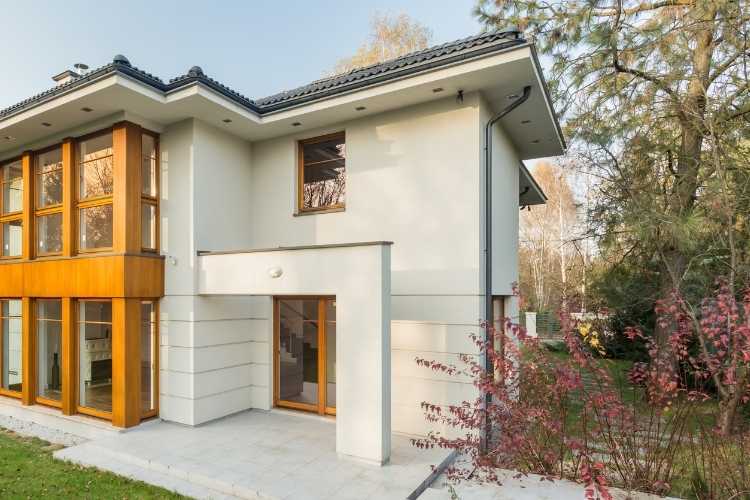Silicone render is perhaps the type of render that's most often considered the 'best'. Of course, there's not really a best when it comes to types of render, because picking the right render is about your Haltwhistle property first. What does it need? Which render will allow it to breathe, or deal with damp or moisture problems, etc.?
But if the property had no say in the matter, many Haltwhistle homeowners would choose silicone render first, because it provides such an attractive finish and is a render system with many benefits built into it.
If you're not sure if silicone rendering is right for you or your home, though, then stick around for today's post.
Here at MisterRender in Haltwhistle, we're experts in plenty of different types of render, and silicone renders are just another example. So if you need to find out everything there is to know about silicone render options for your home, then you're in the right place!
Silicone is a versatile material that's used in many areas, but it's especially well suited to rendering external walls. It's rubbery, heat-resistant and flexible, but its real magic is in its molecules.
Silicone molecules bond together in a unique way that makes it especially strong and durable, whilst also being flexible and having a low thermal conductivity. What does that mean? When you apply silicone render to your house, it acts as external wall insulation does, by keeping the heat in.
A silicone or silicone silicate render is also water repellent, resistant to UV rays so won't discolour easily, and provides a smooth, easy to clean finish that's easily washed and doesn't require regular maintenance.
Silicone render is also a coloured render because colour pigments are mixed into the silicone-cement mixture during the manufacturing process to provide customers with a modern option in a range of colours to increase kerb appeal.
Yes, silicone renders are known as thin coat renders because they only need to be applied in thin coats over an appropriate base coat. Since it essentially acts as a protective top coat, it can also be applied to properties with solid walls (rather than cavity walls) as well as light weighted construction, providing it has a base coat and reinforcing mesh.
This is good news for those with older properties and a less typical house, because it's usually difficult to find a modern render that's suitable for these houses that need to be more breathable. Thankfully, with appropriate preparation and support from professionals like us here at MisterRender, silicone render can be applied to less typical or older properties thanks to its thin coat.
Silicone render is usually applied in a thin layer over a thick base coat that's reinforced with a fibreglass mesh layer. Thin coat silicone renders are slightly more complicated to apply than others because of this initial prep work that's needed in order to ensure the render finish is correct.
This type of render is usually pre mixed and is ready to be applied in a smooth, even coat. Since the colour is already pre mixed into the render, just one coat is enough to get the colour right and the finish perfect.
The top coat render is easy to apply once the initial preparation has been completed and just needs one application.
If applying to an already correctly prepared surface, silicone render can be applied in just a few hours. Since it's just a silicone top coat, it will dry quickly too.
If there isn't a correct base coat render or fibreglass mesh layer in place, then the rendering process will take a lot longer. Since you'll then have to wait for the base coat to dry before applying a thin render silicone top coat. How long exactly depends on drying times, which vary hugely based on weather and humidity.
At MisterRender, we always try to give our best guesses for how long it will take to apply, but with rendering, nothing is guaranteed - apart from our exceptional service, of course.
As mentioned above, silicone render needs to be applied to a surface that's perfect for it. Without this, it's difficult to say whether the finish will be correct and the render will do its job.
In some instances, it's possible to simply apply the silicone render over your existing render, but that's something professionals will have to judge for themselves when they see your render.
In most cases, removing the existing render is necessary to apply the new render correctly.
Modern silicone silicate renders can be given a smooth, flat finish, or have more texture depending on what you prefer. Because it's a through-coloured render, silicone render can be almost any colour, too, so the finished look can be customised to your liking.
And because it's self coloured, you also won't need to paint over it like other renders.

As a render with colour already added into the rendering mix, silicone render needs very little maintenance, and it's also highly durable and weather resistant. For this reason, you can typically expect your new silicone render to last for around 25-30 years.
Perhaps that lifespan sounds too good to be true, but despite only being a through-coloured top coat, silicone renders can easily last that long. It's largely due to the fact that they don't crack or break easily.
Because of how strong silicone molecules are, they help create rendering that's bonded together in a manner that's just as strong. This makes cracking almost impossible, so no, a silicone render is unlikely to crack.
Silicone render is water repellant, meaning water won't be able to soak through it at all. This makes silicone rendering an excellent choice for those who want to avoid penetrating damp. Because it can repel water, it's great at protecting both external and internal walls from damp and moisture problems.
Silicone render is also vapour permeable and breathable too, so damp issues due to moisture being unable to escape from inside the property are less common too!
Your exact silicone render cost depends on a variety of factors. To give you a silicone render cost guide, here's what everything would cost on average if everything needs to happen (from basecoat, right the way through to the silicone top coat):
But that's just the cost of materials. On average, depending on the exact materials used, the number of people working, and the difficulty of the job, you can expect to pay between £45 and £65 per meter squared for labour costs and materials used. That makes silicone renders some of the more expensive options out there.
Here at MisterRender, we try to make our prices as competitive as possible, so contact us today for more information.

To give you a rough idea about how silicone render stacks up against others, it might be helpful to look at some of the other popular render choices so you can think about which is right for you.
In terms of price, cement renders are much cheaper than silicone renders, but they don't last nearly as long and are more prone to cracking. Yes, cement is a relatively cheap render when you look at the price per square metre, but it's likely you'll have to replace it in the future as its lifespan is only between 8 and 15 years.
Unlike acrylic render, silicone render has plenty of colour options. It also doesn't completely seal off the wall like acrylic renders do, meaning the wall and insulation underneath can breathe. Although acrylic is cheaper, sometimes you'll need to opt for a silicone render anyway, in order to avoid moisture problems.
Now that you've seen how it stacks up against cheaper alternatives, let's remind ourselves of some of silicone render's major benefits:
It's true - it may come at a premium but silicone render is a self-cleaning render because it's water repellent and dirt particles are constantly being washed away by the rain, keeping your wall clean and looking great.
Because of how silicone is formed, this top coat is very breathable, preventing moisture and damp problems in the home.
Quick application means less money spent on labour costs. It also means you can improve the look of a wall in a matter of hours!
Talking of improving the look, with built-in colours, you can create a look for your home that's unique and looks amazing without having to ever pick up a paintbrush.
Because silicone is such a strong substance, every exterior wall will be protected for years to come.

Hopefully, this information has taught you that there isn't necessarily a 'best' render out there, just the one that's right for your Haltwhistle property, budget, and you.
If you need help deciding if silicone rendering is the right option for you, then here at MisterRender in Haltwhistle we're happy to discuss your options in greater depth to make sure you get the perfect fit for you. Call us or enquire today, and we'll be able to help you find the perfect render and then apply it for you at competitive prices!

Premium Bio Silicone Render is specifically built with hydrophobic qualities in mind. It's completely waterproof. This means that water is repelled off the render's surface rather than absorbed by it.
The coating protects the exterior of your property against erosion in coastal zones. This kind of rendering with silicone also helps to minimise frost attacks that can damage render and mortar joints, as well as providing more protection and improved insulation to your home.
Silicone renders are pre-colored and do not require painting. Painting them with Emperor Masonry Paint merely allows them to be freshly painted if they have been damaged, and it can also help to prevent algae from sticking to the surface of the render, keeping them looking clean for decades to come.
Additional coats of render can only be safely applied when the existing work is sound and has adequate adhesion across the entire area concerned. Further rendering coats should not be applied over soft, friable material or over previous render that is thicker than 15mm.
